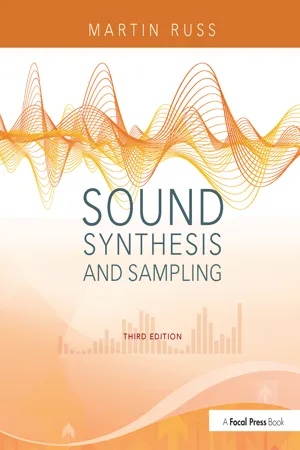
- 568 pages
- English
- ePUB (mobile friendly)
- Available on iOS & Android
Sound Synthesis and Sampling
About This Book
Sound Synthesis and Sampling' provides a comprehensive introduction to the underlying principles and practical techniques applied to both commercial and research sound synthesizers. This new edition has been updated throughout to reflect current needs and practices- revised and placed in a modern context, providing a guide to the theory of sound and sampling in the context of software and hardware that enables sound making. For the revised edition emphasis is on expanding explanations of software and computers, new sections include techniques for making sound physically, sections within analog and digital electronics. Martin Russ is well known and the book praised for its highly readable and non-mathematical approach making the subject accessible to readers starting out on computer music courses or those working in a studio.
Frequently asked questions
Information
PART 2
Techniques
Chapter 2
Making Sounds Physically
- 2.1 Sounds and musical instruments
- 2.2 Hit, scrape and twang
- 2.3 Blow into and over
- 2.4 Sequencing
- 2.5 Recording
- 2.6 Performing
- 2.7 Examples
- 2.8 Questions
- 2.9 Timeline
- To introduce classification systems for musical instruments and sounds, and thereby, to start the discussion of the analysis and synthesis of sound.
- To introduce the chapter contents with a simple example.
2.1 Sounds and Musical Instruments
2.1.1 Instrument
- String instruments
- Wind instruments
- Percussion instruments.
2.1.2 Vibration
- Idiophones, where the sound is produced because the body of the instrument vibrates. Therefore, this group includes percussive instruments such as the marimba, bells and chimes, and wood blocks, as well as less obvious examples such as the triangle and a hand slap on the body of an acoustic guitar.
- Membranophones, where the sound is produced because a tensioned membrane vibrates. This group includes all the drums with a stretched membrane or skin, plus the kazoo!
- Chordophones, where the sound is produced because one or more strings vibrate. This group includes the guitar, violin and harp, as well as harpsichords, hammered dulcimers and pianos.
- Aerophones, where the sound is produced because a column of air vibrates. This group includes the oboe, bagpipes, flutes, horns, trombone and saxophone, as well as the whistle.
- Electrophones, where the sound is produced because a loudspeaker vibrates. This group includes all electronic instruments, although it generally does not include amplification of another type of instrument, and therefore, the electric guitar is still classified as a chordophone because the vibrating string is the initial source of the vibration.
2.2 Hit, Scrape and Twang
| Hit | Scrape | Twang | Blow | |
|---|---|---|---|---|
| Idiophones (3D) | Marimba, wood block | Scraper, waterphone, cuica | Jew's harp, thumb piano | Aeolsklavier |
| Membranophones (2D) | Drums | Jazz brushes | Kazoo | |
| Chordophones (1D string) | Piano, guitar hammer-on | Violin | Guitar, koto | |
| Aerophones (1D air) | Wind, brass |
2.3 Blow Into and Over
2.4 Sequencing
Table of contents
- Cover
- Half Title
- Title Page
- Copyright Page
- Table of Contents
- Preface to First Edition
- Preface to Second Edition
- Preface to Third Edition
- Visual Map
- About this Book
- Background
- Techniques
- Applications
- Analysis
- Bibliography
- Jargon
- Index